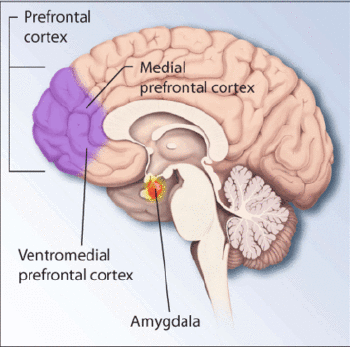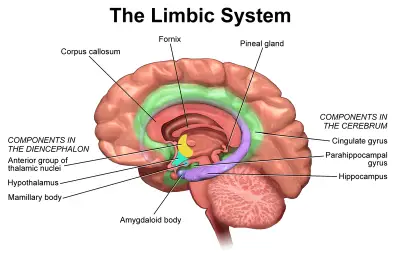Phobia

The term phobia, from the Greek φόβος meaning "fear," is a strong, persistent, and irrational fear or anxiety of certain situations, objects, activities, or persons. A phobia disorder is defined by an excessive, unreasonable desire to avoid the feared subject. Phobias are generally believed to emerge following highly traumatic experiences. Many individuals suffering from certain phobias are believed to transfer the fear of an original situation to other situations experienced in or reoccurring throughout everyday life, while the original fear is often left forgotten. Such an example can be seen in near-drowning incidents; an individual may often develop an irrational fear of water, despite minimizing the original fear of drowning.
Behavior therapy, or the gradual exposure of an individual to certain objects of their most irrational fears, is generally accepted as the best method for overcoming certain phobias. However, the origin and continued recurrence, generation after generation, has yet to be solved.
Overview
Phobias, or phobic disorders, are defined as an intense, irrational fear that often leads to the extreme avoidance of the object or situation feared. The word "phobia" comes from the Greek: φόβος (phóbos), meaning "aversion," "fear." or "morbid fear."
Phobias are common and believed to originate in childhood or adolescent experiences, although some common phobias have been suggested as being inborn, such as fear of heights or snakes.
The Diagnostic and Statistical Manual of Mental Disorders, Fifth Edition (DSM-V), classifies phobias into three major categories: specific phobias, social phobias, and agoraphobia.
Specific phobias
Specific phobias are defined as a fear of a particular situation or object, and are the most common types of phobic disorders experienced. Specific phobias are believed to be hereditary and are common among family members. Some specific phobias include the fear of snakes, flying, dogs, elevators, and spiders. Specific phobias are a type of anxiety disorder.
Social phobia
Social phobia, also known as Social anxiety disorder, is defined by a fear of being watched or judged by others, and can include a deep fear of public embarrassment. A social phobia may also encompass a general fear of social situations, and a subsequent experience of severe anxiety when in them. Individuals experiencing social phobia may worry excessively about upcoming social situations, and may avoid events in which they may feel self-conscious. In extreme cases, individuals experiencing such phobia may deny job offers or avoid relationships due to their fears. Social phobia is also a type of anxiety disorder
Agoraphobia
Agoraphobia, often believed to be the fear of open spaces, is actually the fear of feeling trapped and having a panic attack within a public space. These situations can include open spaces, public transit, shopping centers, or simply being outside their home. Agoraphobia is strongly linked with panic disorder and is often precipitated by the fear of having a panic attack. A common manifestation involves needing to be in constant view of a door or other escape route. Individuals suffering from agoraphobia often develop to avoidance behaviors. For example, following a panic attack while driving, someone with agoraphobia may develop anxiety over driving and will therefore avoid driving. These avoidance behaviors can have serious consequences and often reinforce the fear they are caused by. In a severe case of agoraphobia, the person may never leave their home.
Agoraphobia is believed to develop between the ages of 15 and 35 and is most prevalent in women. Agoraphobia often develops from an initial panic attack; after such an attack, an individual may deeply fear having another. Patients suffering from agoraphobia may incessantly fear when the next attack may occur, often generalizing their fear with one of public spaces and social settings. In its most extreme form, a patient may be unable to leave their home.
Symptoms
Most individuals experiencing a phobic disorder experience an anxious phobic reaction when encountering the feared object or situation. Though the triggers of certain phobias are often different, individuals dealing with phobias often face similar symptoms. Such symptoms include a feeling of terror of impending doom, rapid heartbeat and breathing, and sweaty palms. Such reactions can also consist of extreme fearfulness, elevated blood pressure, physical shaking, hot or cold flashes, nausea, and irrational cognitive reasoning. Once the individual is removed from the feared situation, these effects quickly subside; this degree of relief is believed by psychologists to reinforce the phobia and to further strengthen the avoidance of the individual to the feared object or situation. In more extreme cases, a "phobic trigger" may occur; someone struggling with a fear of water may experience episodes of panic attacks weeks before a planned vacation to the beach.
Causes
Research on phobic disorders has suggested the development of certain phobias to be both hereditary and situational. While specific phobias are often believed to be hereditary, many psychologists also identify a link with certain phobias and negative past experiences. For example, prolonged flight turbulence may trigger a subsequent fear of flying.
Most social phobias are believed to originate in a childhood or adolescent experience. Certain individuals who have experienced repeated rejection, especially during formative years, may subsequently develop poor social skills, low levels of self esteem, and an ensuing social phobia.
More is known about conditions of agoraphobia. Because panic attacks may develop spontaneously, an individual may often develop a gripping fear of when his or her next attack may be. This can lead to the avoidance of places where an individual may feel he or she could not escape if a panic attack did occur.
Mechanism
Limbic system
Beneath the lateral fissure in the cerebral cortex, the insula, or insular cortex, of the brain has been identified as part of the limbic system, along with the cingulated gyrus, hippocampus, corpus callosum, and other nearby cortices. This system has been found to play a role in emotion processing, and the insula, in particular, may contribute to maintaining autonomic functions.
In the frontal lobes, other cortices involved with phobia and fear are the anterior cingulate cortex and the medial prefrontal cortex. The ventromedial prefrontal cortex has been said to influence the amygdala by monitoring its reaction to emotional stimuli or even fearful memories. Most specifically, the medial prefrontal cortex is active during the extinction of fear and is responsible for long-term extinction. Stimulation of this area decreases conditioned fear responses, so its role may be in inhibiting the amygdala and its reaction to fearful stimuli.
The hippocampus is a horseshoe-shaped structure that plays an essential part in the brain's limbic system. This is because it forms memories and connects them with emotions and the senses. When dealing with fear, the hippocampus receives impulses from the amygdala that allow it to connect the fear with a certain sense, such as a smell or sound.
Amygdala
The amygdala is an almond-shaped mass of nuclei located deep in the brain's medial temporal lobe. It processes the events associated with fear and is linked to social phobia and other anxiety disorders. The amygdala's ability to respond to fearful stimuli occurs through fear conditioning. Like classical conditioning, the amygdala learns to associate a conditioned stimulus with a negative or avoidant stimulus, creating a conditioned fear response often seen in phobic individuals. The amygdala is responsible for recognizing certain stimuli or cues as dangerous and plays a role in the storage of threatening stimuli to memory. The basolateral nuclei (or basolateral amygdala) and the hippocampus interact with the amygdala in-memory storage. This connection suggests why memories are often remembered more vividly if they have emotional significance.
In addition to memory, the amygdala also triggers the secretion of hormones that affect fear and aggression. When the fear or aggression response is initiated, the amygdala releases hormones into the body to put the human body into an "alert" state, which prepares the individual to move, run, fight, etc. This defensive "alert" state and response are known as the fight-or-flight response.
However, inside the brain, this stress response can be observed in the hypothalamic-pituitary-adrenal axis (HPA). This circuit incorporates the process of receiving stimuli, interpreting them, and releasing certain hormones into the bloodstream, ultimately stimulating the release of cortisol. In relation to anxiety, the amygdala activates this circuit, while the hippocampus is responsible for suppressing it. Glucocorticoid receptors in the hippocampus monitor the amount of cortisol in the system and through negative feedback can tell the hypothalamus to stop releasing CRH. People with phobias, therefore, may have high amounts of cortisol present, or low levels of glucocorticoid receptors.
Treatment
Phobias may be treated by various forms of therapy, ranging from techniques based on behavior therapy, such as systematic desensitization, to more cognitive therapies, such as exposure therapy.
Systematic desensitization is a type of behavioral therapy used to help effectively overcome phobias and other anxiety disorders. More specifically, it is a type of Pavlovian therapy developed by South African psychiatrist, Joseph Wolpe. To begin the process of systematic desensitization, one must first be taught relaxation skills in order to control fear and anxiety responses to specific phobias. Once the individual has been taught these skills, he or she must use them to react towards and overcome situations in an established hierarchy of fears. The goal of this process is that an individual will learn to cope and overcome the fear in each step of the hierarchy, which will lead to overcoming the last step of the fear in the hierarchy. Systematic desensitization is sometimes called "graduated exposure therapy."
Many phobias are treated through exposure therapy, or the gradual exposure of the feared object to the individual in successively longer time periods. Exposure therapy is believed to be the best approach for certain phobias as the individual is placed in an environment of comfort at all times when exposed to the object. Exposure therapy is a cognitive behavioral therapy technique for reducing fear and anxiety responses, especially phobia, and is based on the principles of habituation and cognitive dissonance. It is similar to Systematic desensitization, though it works more quickly and produces more robust results. It is also very closely related to Exposure and response prevention, a method widely used for the treatment of Obsessive-compulsive disorder. Three fourths of patients show significant improvement from this treatment.
Cognitive therapy is also used in the treatment of phobic disorders and involves an analysis of one’s thoughts and beliefs in phobic situations. By helping individuals recognize the relationship between one’s thoughts and one’s anxiety, and that the majority of feared outcomes are unlikely, psychologists help phobic individuals to gain more control over their feared situation.
Some medications can be prescribed in the treatment of phobias. Beta-adrenergic blocking agents help to lower heart rate and reduce physical tremors, and help to reduce general anxiety within phobic patients. Antidepressants are also believed to affect certain regions of the brain in which fear is mediated, further helping to reduce anxiety in panic-prone patients. Other prescriptions involve life-changes such as the elimination of caffeine, alcohol, and stress, and maintaining a healthy diet and exercise.
Prognosis
Most phobias are highly treatable and individuals can often go on leading normal lives. Research has shown that once a person is rid of a phobia, it is less likely, if ever likely, to return. In matters where certain phobias are left untreated, an individual may be inflicted for life. In some cases, untreated phobias can lead to other problems and disorders, including depression, low self-esteem, and social avoidance. Psychologists suggest most adult phobias to be treated; however only 25 percent of people experiencing phobias are believed to seek help.
Examples of phobias
There exist more than 600 recognized phobias, many without treatment. Several common examples are detailed below.
Acrophobia
Acrophobia, a specific phobia from the Greek word ἄκρος, meaning "summit" is an extreme or irrational fear of heights. Acrophobia can prove dangerous, as sufferers may often experience a panic attack in a high place and become unable to get themselves down safely. Some acrophobics also suffer from urges to throw themselves off high places, despite not being suicidal.
The most widely accepted explanation is that acrophobia stems from the fear of falling and being injured or killed. This is classified as a normal and rational fear that most people have.
Arachnophobia
Arachnophobia is an intense and unreasonable fear of spiders and other arachnids such as scorpions. People with arachnophobia tend to feel uneasy in any area they believe could harbor spiders or that has visible signs of their presence, such as webs. If arachnophobes see a spider, they may not enter the general vicinity until they have overcome the panic attack that is often associated with their phobia. Some people run away, scream, cry, have emotional outbursts, experience trouble breathing, sweat, have increased heart rates, or even faint when they come in contact with an area near spiders or their webs. In some extreme cases, even a picture or a realistic drawing of a spider can trigger intense fear. Treatment is typically by exposure therapy, where the person is presented with pictures of spiders or the spiders themselves.
Aviophobia
Aviophobia is a strong fear of flying, or a fear of air travel. It is also sometimes referred to as "aviatophobia" or "aviophobia." Though commercial flight has become an prevalent part of modern life, flying continues to cause a significant proportion of the public to feel anxious.
Some people who are afraid of flying manage their fears well enough that they are able to fly, but may still spend considerable time and emotional energy thinking about the dangers that may befall them during flight. In extreme cases individuals are nearly incapable of getting on an airplane, and must use other means of transportation to achieve long distance travel.
Like many phobias, fear of flying may "generalize" to cause fear of flight-related situations or stimuli. Many individuals with a strong fear of flying report anxious symptoms or panic attacks when discussing air travel, when seeing airplanes overhead, when visiting airports, or when watching television programs or films that depict air travel.
Claustrophobia
Claustrophobia is an anxiety disorder that involves the fear of enclosed or confined spaces. Those suffering from claustrophobia may suffer from panic attacks, or fear of having a panic attack, in situations such as being in elevators, trains, or aircraft.
Conversely, people who are prone to having panic attacks will often develop claustrophobia. If a panic attack occurs while they are in a confined space, then the claustrophobe fears not being able to escape the situation. Those suffering from claustrophobia might find it difficult to breathe in closed auditoriums, theaters, and elevators. Claustrophobia can be treated in similar ways to other anxiety disorders, with a range of treatments including cognitive behavior therapy and the use of anti-anxiety medication.
Xenophobia
Xenophobia denotes a phobic attitude towards strangers or of the unknown. It comes from the Greek words ξένος (xenos), meaning "foreigner," "stranger," and φόβος (phobos), meaning "fear." The term is typically used to describe fear or dislike of foreigners.
Xenophobia implies a belief, accurate or not, that the target is in some way foreign. Prejudice against women cannot be considered xenophobic in this sense, except in the limited case of all-male clubs or institutions. The term xenophilia is used for the opposite behavior, attraction to or love for foreign persons.
ReferencesISBN links support NWE through referral fees
- American Psychiatric Association. Diagnostic and Statistical Manual of Mental Disorders, 5th Edition: DSM-5. American Psychiatric Publishing, 2013. ISBN 978-0890425558
- Bear, Mark, Barry Connors, and Michael A. Paradiso. Neuroscience: Exploring the Brain. Jones & Bartlett Learning, 2020. ISBN 978-1284211283
- Whalen, Paul J., and Elizabeth A. Phelps (eds.). The Human Amygdala. The Guilford Press, 2009. ISBN 978-1606230336
- Wolpe, Joseph. The Practice of Behavior Therapy. Allyn & Bacon, 1992. ISBN 0205145140
External Links
All links retrieved November 23, 2022.
- The Phobia List Phobias & their Technical Names.
- Online Treatment for Anxiety Enhance Health Group.
- Common and Unique Phobias Explained Healthline.
- Phobias Johns Hopkins Medicine.
- Phobias Medline Plus.
Credits
New World Encyclopedia writers and editors rewrote and completed the Wikipedia article in accordance with New World Encyclopedia standards. This article abides by terms of the Creative Commons CC-by-sa 3.0 License (CC-by-sa), which may be used and disseminated with proper attribution. Credit is due under the terms of this license that can reference both the New World Encyclopedia contributors and the selfless volunteer contributors of the Wikimedia Foundation. To cite this article click here for a list of acceptable citing formats.The history of earlier contributions by wikipedians is accessible to researchers here:
- Phobia history
- Acrophobia history
- Specific_phobia history
- Fear_of_flying history
- Claustrophobia history
- Xenophobia history
- Agoraphobia history
The history of this article since it was imported to New World Encyclopedia:
Note: Some restrictions may apply to use of individual images which are separately licensed.



